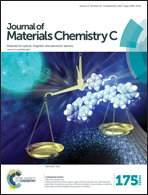9-Anthryl-capped DPP-based dyes: aryl spacing induced differential optical properties
Abstract
While pyrrolo[3,4-c]pyrrole-1,4(2H,5H)-diones (DPPs) are extensively used as building blocks in field-effect transistors and photovoltaic active layers, less attention has been paid to the construction of novel optical materials. In this work, we have designed and synthesized two soluble 9-anthryl-capped DPP derivatives with benzene and thiophene as spacing units, 1,4-diketo-2,5-dioctyl-3,6-bis(9-anthrylphenyl)pyrrolo[3,4-c]pyrrole (ABDPP) and 1,4-diketo-2,5-dioctyl-3,6-bis(9-anthrylthiophen)pyrrolo[3,4-c]pyrrole (ATDPP). It is found that ABDPP and ATDPP emit strong and weak fluorescence in solution, respectively, but their crystalline states all exhibit strong fluorescence, implying that only ATDPP exhibits an aggregation-enhanced emission (AEE) effect although the two dyes all adopt a twisted conjugation backbone. Interestingly, grinding and pressing can only change the fluorescence color of crystalline ABDPP from yellow to red, contributing a non-AEE dye exhibiting mechanochromic luminescence. Differential scanning calorimetry and powder X-ray diffraction analyses confirm that the phase transition between the crystalline and amorphous states upon application of external stimuli is responsible for the reversible color change. This work has demonstrated once again that a subtle manipulation of the molecular structure unit could significantly tune and alter the optical properties of conjugated organic materials.


 Please wait while we load your content...
Please wait while we load your content...